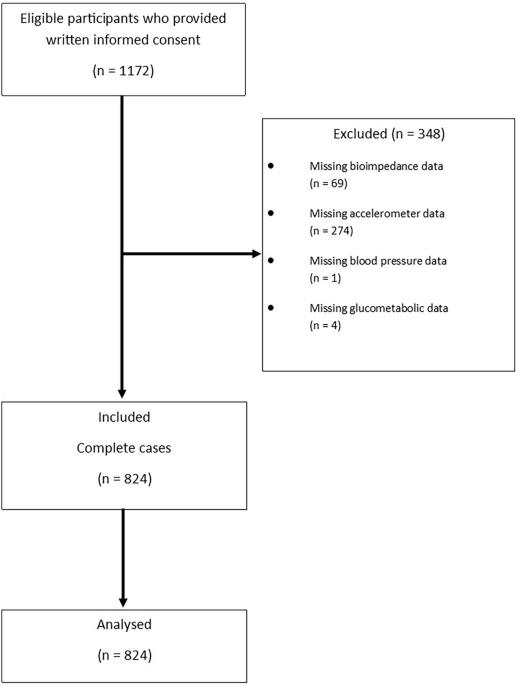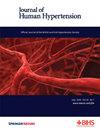中度至剧烈体育活动对新近诊断为2型糖尿病的丹麦成人全身血管阻力的影响:一项横断面研究
IF 3.4
4区 医学
Q2 PERIPHERAL VASCULAR DISEASE
引用次数: 0
摘要
剧烈运动可能通过降低全身血管阻力(SVR)来减轻血压升高(BP)的风险。使用logistic多变量回归模型,我们研究了中度至剧烈体育活动(MVPA)是否与成人2型糖尿病(T2DM)患者的高SVR负相关。此外,我们评估了其他心脏代谢危险因素与SVR之间的关系。采用胸电生物阻抗法评估SVR;高SVR定义为高于正常水平≥20%。使用加速度计数据和年龄特异性切割点计算MVPA花费的时间。在空腹血液样本中,我们测量了血浆葡萄糖和c肽,并使用稳态模型评估2-胰岛素抵抗(HOMA2-IR)来估计胰岛素抵抗。结果根据年龄、性别、血压、体重指数(BMI)、HOMA2-IR、药物和吸烟进行了调整。我们纳入了824名新近诊断为T2DM的成年人(平均年龄= 61.6岁)(糖尿病病程四分位数范围= 4.9年)。41%是女性。中位MVPA为10.7 min/d, 50.5%具有高SVR。MVPA增加14.4分钟/天与高SVR风险降低独立相关(OR = 0.69,[0.57;0.83])。高SVR的其他危险决定因素为女性(OR = 2.06, [1.49;2.86]), BMI每增加6.16 kg/m2 (OR = 2.20, [1.76;2.73]), HOMA2-IR为1.79 (OR = 2.33,[1.09;4.96])。在比较决定系数时,BMI对SVR解释变异性的影响明显大于MVPA(伪r2, 35.0% vs. 7.9%)。虽然MVPA水平的增加与SVR高风险的降低有关,但BMI似乎对SVR有更明显的影响。本文章由计算机程序翻译,如有差异,请以英文原文为准。

Impact of moderate to vigorous physical activity on systemic vascular resistance in Danish adults with recently diagnosed type 2 diabetes: a cross-sectional study
Strenuous physical activity alleviates the risk of elevated blood pressure (BP) presumably through a reduction in systemic vascular resistance (SVR). Using logistic multivariate regression models, we investigated whether moderate to vigorous physical activity (MVPA) was negatively associated with high SVR among adults with Type 2 Diabetes (T2DM). Additionally, we assessed associations between other cardiometabolic risk factors and SVR. SVR was assessed using thoracic electrical bioimpedance; high SVR was defined as ≥20% above normal. Time spent on MVPA was calculated using accelerometer data and age-specific cut points. In fasting blood samples, we measured plasma glucose and c-peptide and used the Homeostasis Model Assessment 2-Insulin Resistance (HOMA2-IR) to estimate Insulin resistance. Results are adjusted for age, sex, BP, body mass index (BMI), HOMA2-IR, medication, and smoking. We included 824 adults (mean age = 61.6 years) with recently diagnosed T2DM (interquartile range for diabetes duration = 4.9 years). 41% were females. Median MVPA was 10.7 min/day, and 50.5% had high SVR. Increments of 14.4 min/day in MVPA were independently associated with a lower risk of high SVR (OR = 0.69, [0.57;0.83]). Other risk determinants of high SVR were female sex (OR = 2.06, [1.49;2.86]), each increase in BMI of 6.16 kg/m2 (OR = 2.20, [1.76;2.73]), and HOMA2-IR of 1.79 (OR = 2.33, [1.09;4.96]). BMI had a notably greater impact on explained variability of SVR than MVPA when comparing the coefficient of determination (pseudo-R2, 35.0% vs. 7.9%). Although increased levels of MVPA are associated with a reduced risk of high SVR, BMI appears to have a more pronounced effect on SVR.
求助全文
通过发布文献求助,成功后即可免费获取论文全文。
去求助
来源期刊

Journal of Human Hypertension
医学-外周血管病
CiteScore
5.20
自引率
3.70%
发文量
126
审稿时长
6-12 weeks
期刊介绍:
Journal of Human Hypertension is published monthly and is of interest to health care professionals who deal with hypertension (specialists, internists, primary care physicians) and public health workers. We believe that our patients benefit from robust scientific data that are based on well conducted clinical trials. We also believe that basic sciences are the foundations on which we build our knowledge of clinical conditions and their management. Towards this end, although we are primarily a clinical based journal, we also welcome suitable basic sciences studies that promote our understanding of human hypertension.
The journal aims to perform the dual role of increasing knowledge in the field of high blood pressure as well as improving the standard of care of patients. The editors will consider for publication all suitable papers dealing directly or indirectly with clinical aspects of hypertension, including but not limited to epidemiology, pathophysiology, therapeutics and basic sciences involving human subjects or tissues. We also consider papers from all specialties such as ophthalmology, cardiology, nephrology, obstetrics and stroke medicine that deal with the various aspects of hypertension and its complications.
 求助内容:
求助内容: 应助结果提醒方式:
应助结果提醒方式:


